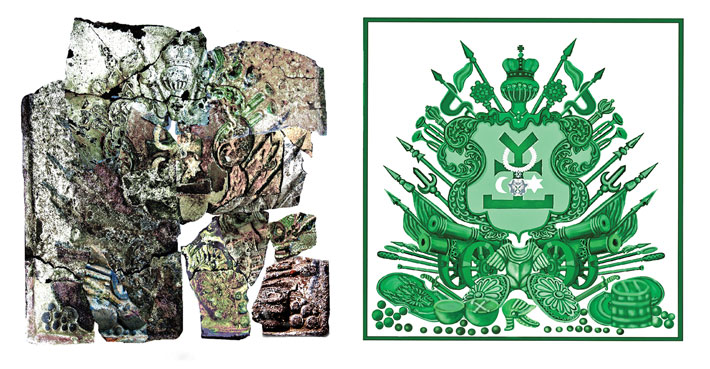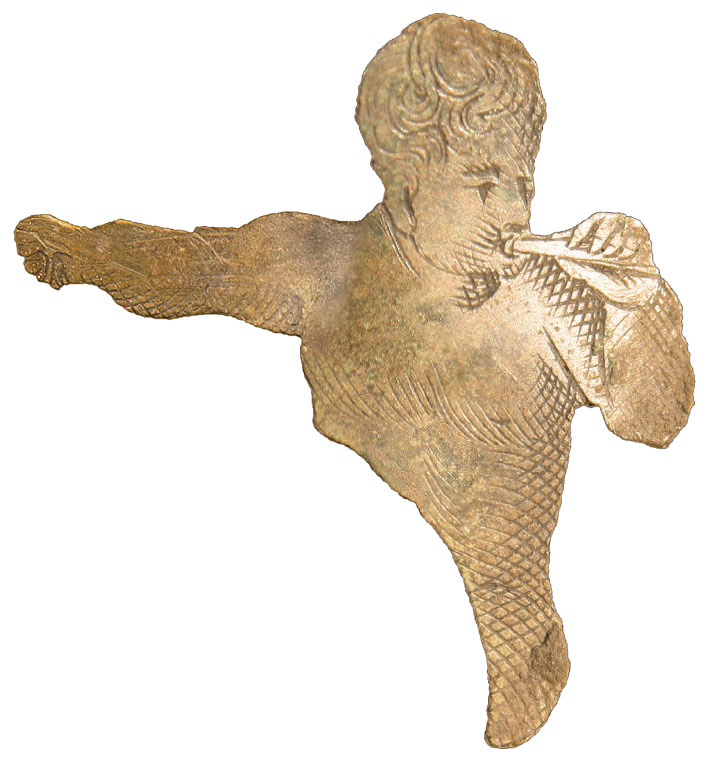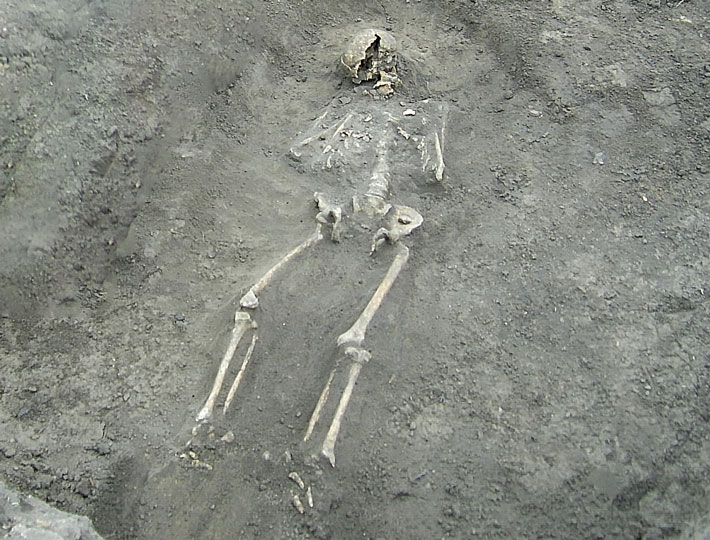Peter’s support allowed Mazepa to rule the hetmanate as he wished, and the unaccustomed absence of strife freed him to focus on cultural development. “Peter signed a new agreement that allowed the hetmanate to be completely autonomous, and Mazepa was able to control all the taxes and income he collected,” says Tairova-Yakovleva. “This gave him the opportunity to spend as he wanted, to support literature, painting, and education.” The Kyiv-Mohyla Academy, where Mazepa had begun his own schooling, became the favored educational institution for both the Ukrainian and Russian elite. The majority of the religious figures who drove Peter’s efforts to reform the Russian Orthodox Church by bringing it under increased state control came from the hetmanate. “In many regards, Mazepa supported Peter’s ideas and played an important role in the early stages of establishing the Russian Empire,” says Tairova-Yakovleva. “He believed the changes in the Muscovy state would be helpful to Ukraine because society would become more modern, more European, and more educated.” Mazepa himself restored and built many churches, including the Baroque brick Cathedral of the Holy Trinity in the Baturyn fortress, which was completed around 1692 and is believed to have featured five domes. When archaeologists excavated the cathedral’s foundations, they found that it measured 127 by 80 feet, making it one of the Cossack state’s largest churches.

Archaeologists have also spent years unearthing the remains of Mazepa’s personal residence in Honcharivka, which the hetman completed by 1700. These excavations have produced extensive evidence of Mazepa’s efforts to import Western European styles, to which he was exposed during his university days. The fortified villa covered 22 acres and had defenses modeled on contemporaneous Dutch strongholds. In addition to its three-story Baroque masonry palace, it included a fruit garden and birch grove, laid out in a network of straight lines resembling a French park. The design of the palace was striking, with ceramic column bases, brick semicolumns, and carved limestone Corinthian capitals, all painted bright red. The columns flanked the structure’s front entrance and contrasted with its whitewashed walls. Adorning the friezes at the top of each story were dozens of glazed ceramic rosettes, disks with multicolored patterns that resemble stylized flowers. During their excavations, archaeologists found pieces of the columns with remnants of their red ocher paint, as well as many rosette fragments coated with white, yellow, turquoise, and blue enamel. In addition to its design, the palace stood out for its height, given that Cossack houses tended to be one story. “Some archaeologists have doubted it was three stories because that was atypical for Ukrainian residences of the time,” says Mezentsev. “But why should Mazepa follow local tradition? He was a very Western-oriented man.”

Amid the burned remnants of the palace, archaeologists have found numerous fragments of glazed ceramic and terracotta tiles decorated with floral motifs, coats of arms, and angels or cherubs, which once lined the structure’s stoves. The palace’s floors were paved with glazed green, blue, and yellow ceramic tiles of various shapes. According to Mezentsev, these tiles were likely fashioned by top ceramicists from Kyiv, whom Mazepa brought to his capital. Other finds at the palace, including fragments of engraved Bohemian glassware, speak to the salon-like atmosphere the hetman is known to have fostered there. A French diplomat named Jean de Baluze, who attended a lavish reception at the palace in 1704, reported that Mazepa conversed with several Italian artisans and German physicians in their native languages, while sprinkling his conversation with Latin quotations. “Mazepa established a court that was really remarkable in reflecting the Baroque era of literature and art,” says Zenon Kohut, former director of CIUS at the University of Alberta, who founded the Baturyn archaeological project and oversaw it for its first 14 years. “He was considered one of the most cultured people of the time throughout the entire Russian sphere.”
Baluze also noted that the palace housed an impressive collection of rare weapons and a reception hall lined with portraits of contemporaneous rulers, such as King Louis XIV of France (reigned 1643–1715), a Habsburg emperor, a Polish king, and a Turkish sultan. According to Mazepa’s right-hand man, Orlyk, the palace housed one of the most extensive libraries of its time, stocked with numerous books, including centuries-old German and Latin volumes and illuminated manuscripts. Save for what Russian troops spirited back to Muscovy, all of this went up in flames. One memento of Mazepa’s great library that was found by archaeologists was an engraved bronze plate depicting a nude man playing a trumpet. “It resembles an angel without wings,” says Mezentsev. “This plate may have come from the casing of a religious book made in Italy during the Renaissance or Baroque era.”

Throughout 1708, the conversations at Mazepa’s palace in Honcharivka grew increasingly dark and urgent. Eight years earlier, in 1700, Peter, set on challenging the supremacy of the Swedish Empire, had initiated the Great Northern War. Despite some misgivings regarding his military adventurism, Mazepa supported the czar, providing troops and resources. In 1704, Peter sent Mazepa to get control of the Right Bank Cossacks and then allowed the hetman to incorporate them into his hetmanate, uniting Right Bank and Left Bank Ukraine for the first time in decades. By 1707, however, Charles XII of Sweden (reigned 1697–1718) had vanquished Peter’s major allies—Denmark, Saxony, and the Polish-Lithuanian Commonwealth—and was advancing toward Muscovy. The Swedes, short on food and gunpowder, detoured toward grain-rich Ukraine to replenish their supplies. Peter refused to defend the hetmanate and ordered Mazepa to burn the territory in the Swedes’ path. Unwilling to sacrifice the towns, villages, and churches he’d labored to build up, and displeased by Peter’s cavalier treatment of the hetmanate’s military resources and increasingly meddlesome approach to its affairs, Mazepa formed an alliance with Charles. This led to Peter’s vengeful targeting of Baturyn. “The czar had relied on Mazepa for advice on his foreign policy, on his diplomacy,” says Kohut. “That’s why Peter was so enraged when Mazepa changed sides. There was a personal aspect to it.”
Exactly how the Russian forces overwhelmed the defenses of the Baturyn fortress and citadel has been a matter of debate. One theory holds that a Cossack traitor led the invaders through an underground passageway. Archaeologists unearthed just such a tunnel, leading nearly 150 feet from the banks of the Seim River to the basement of the wooden Church of the Resurrection, which stood on the citadel. Little remained of the church itself, as it was burned after the attack, but researchers were able to identify its location based on their discovery of its large cemetery. Mezentsev believes the Russians also used artillery to blow a hole in the fortress wall and then stormed through it. He points out that the fortress was originally built by the Poles in the early to mid-seventeenth century, when they controlled the area. It was later restored and modified by several hetmans, including Mazepa, but didn’t provide a formidable defense in 1708. “For the mid-seventeenth century, the fortress was probably okay,” says Mezentsev, “but it was obsolete by the end of the century, when siege artillery had become more powerful.” During excavations of the log-lined moat surrounding the citadel, archaeologists found that it was clogged with silt and hadn’t been cleaned regularly.

Within the fortress, archaeologists uncovered three large granaries with 32 grain pits, evidence of the copious provisions that Mazepa had hoped to share with the Swedes—and that Peter successfully deprived them of. They also discovered extensive evidence of the destruction wrought by the Russians. There were numerous cannonballs, musket balls, and arrowheads. Bricks and glass dishes had been melted by the fire. In the cemetery of the Church of the Resurrection, a lower layer of peacetime burials consisted mainly of elderly people interred in coffins at least three or four feet underground. Above them was a layer of shallow burials, mostly children or teenagers, with no trace of coffins. In the earthen fill of these burials, archaeologists found rubble from a nearby building that was destroyed in 1708. “They were buried in November after Baturyn was taken, and it was early winter, so the ground was frozen,” says Mezentsev. “They couldn’t dig deep pits for the graves.” In the ruins of the Cathedral of the Holy Trinity, archaeologists uncovered more than 400 burials, a significant portion containing victims of the massacre. “There are many skeletons with trauma from military action,” says Mezentsev. “There are skulls with bullet holes, severed hands and legs, and bones burned by the fire.” Archaeologists believe that every cemetery in Baturyn and its suburbs dating to the late seventeenth and early eighteenth century includes burials of civilian victims of the 1708 massacre. The graves of the soldiers who died defending the capital have yet to be located.
In the months after Baturyn was destroyed, Mazepa and Peter competed for the support of the Cossacks, with Mazepa accusing Peter of encroaching on Cossack autonomy and the czar tarring the hetman as a traitor. Peter had the Orthodox Church expel Mazepa by declaring an anathema against him. The czar installed a new hetman and succeeded in winning over the majority of the Cossacks, likely due to their horror at the destruction of Baturyn and revulsion at Mazepa’s rejection by the Church. When the armies of Charles and Peter faced off on July 8, 1709, near the city of Poltava, 175 miles southeast of Baturyn, Mazepa and around 5,000 Cossacks fought on the Swedish side, while more than three times as many took the side of Muscovy. The Swedes were so short on gunpowder that they could only use four of their 34 cannons and were soundly defeated. Charles and Mazepa fled to Ottoman Moldavia, southwest of Ukraine, where the hetman died several months later at the age of 70.
Mazepa’s gambit clearly failed, but according to Tairova-Yakovleva, he was in a no-win situation given Peter’s imperial ambitions. “If Mazepa hadn’t gone to the Swedish side, then we can foresee what would have happened,” she says. “Ukraine would have been destroyed by Peter and would have lost its autonomy. Mazepa had no great choice in terms of what to do, but at least he was brave enough to try.” In the aftermath of the Battle of Poltava, the hetmanate lost much of its independence. It then gained some of it back, but was eventually abolished and absorbed into the Russian Empire in 1764 under the empress Catherine the Great (reigned 1762–1796). The territory that Mazepa had built into a bastion of Cossack sovereignty was now known as the Little Russia Governorate.





